| |
| Brazil |
 |
| ...is
my favourite! |
|
When
I first entered the country, at a tiny border in the
Amazon called Bejamin Constant, I noticed that I easily
could mingle with the local population. Different from
the other countries I visited before, where most of
them were indigenes-dark skinned, the people in Brazil
were all sorts of skinteinted. There were dark ones,
very dark ones, whites...probably emigrants from Europe
etc.
For hundreds of
years, Brazil has symbolised the great escape into a
primordial, tropical paradise, igniting the Western
imagination like no other South American country. From
the mad passion of Carnaval to the immensity of the
dark Amazon, Brazil is a country of mythic proportions.
The gap between
rich and poor is hughs...especially
in the country, Amazon and the favellas(suburbs) of
the big cities the poor people live...but
most of them accept their situation and are happy an
content with what they've got.
|
|

|
|
Brazilian
Children sharing the meal
|
|
| The Amazon
is a gigantic system of rivers and forests, covering half
of Brazil and extending into neighbouring countries. The
stretch of river known as Rio Amazonas runs between the
cities of Manaus and Belém, though the various rivers
which join to form it provide a navigable route for ocean-going
vessels to the other side of the South American continent.
The forest still keeps many of its secrets: to this day
major tributaries of the Amazon are unexplored. Of the
estimated 15,000 species of Amazon creatures, thousands
of birds and fish and hundreds of mammals have not been
classified. A cursory sampling of known animal species
found in the forest - some common, some rare, some virtually
extinct - includes jaguar, tapir, peccary, spider monkey,
sloth, armadillo, caiman, alligator, river dolphin, boa
constrictor and anaconda. Forest birds include toucans,
parrots, macaws, hummingbirds and hawks; insect life is
well represented with over 1800 species of butterflies
and more than 200 species of mosquitoes; and fish such
as piranha, tucunaré, piraracu, pintado and electric eel
abound in such an amazing diversity of fish species that
biologists are unable to identify 30% of the catch found
in Belém's markets. The most common jumping-off point
for excursions into the Amazon is Manaus, which lies beside
the Rio Negro, 10km upstream from the confluence of the
Solimões and Negro rivers, which join to form the Amazon.
Although Manaus continues to be vaunted in countless glossy
travel brochures as an Amazon wonderland, the city itself
has few attractions and is dirty, ugly and increasingly
crime-ridden. The city's most potent symbol is the Teatro
Amazonas, the famous opera house designed by Domenico
de Angelis in Italian Renaissance style at the height
of the rubber boom, in 1896. Day trips and boat tours
up the Amazon provide a close-up experience of the jungle
flora and abundant bird life, and a chance to see what
life is like for the caboclos (inhabitants of the Amazonian
river towns) in the vicinity of Manaus, but don't expect
to meet remote Indian tribes or dozens of free-ranging
beasts, because in both cases contact has been synonymous
with destruction, and both have sensibly fled from accessible
areas. |
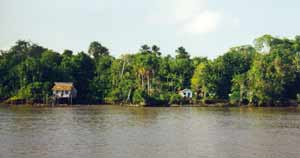
In the Amazon
some hours before the coastal city Belém, 1998
| The 6275km long
Amazon is the world's largest river, and the Amazon forest
contains 30% of the world's remaining forest. The richness
and diversity of Brazil's fauna is astounding, and the
country ranks first in the world for numbers of species
of primates, amphibians and plants; third for bird species;
and fourth for species of butterflies and reptiles. However,
many species are under threat because of the continued
depletion of rainforests, desertification in the north-east,
poaching in the Pantanal region and coastal pollution.
|
|
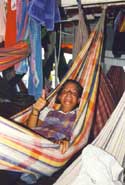
|
For
nine days I had to sleep in this hammock on the way from
Manaus in the Amazon to Belém at the eastcoast.
That was an experience for life...just to have your hammock
as your home with your luggage underneath...To get on
the ferry was the only way of transport in the amazon.
So plenty of time to practice some brazilian portugiese... |
| Me
in the hammock |
| |
|
Rio de Janeiro
Jammed into the world's most beautiful setting - between
ocean and escarpment - are seven million Cariocas, as
Rio's inhabitants are called. The Cariocas pursue pleasure
like no other people: beaches and the body beautiful;
samba and beer; football and the local firewater, cachaça.
Rio has its problems, and they are enormous: a third
of the people live in the favelas (shanty towns) that
blanket many of the hillsides; the poor have no schools,
no doctors, no jobs; drug abuse and violence are endemic;
police corruption and brutality are commonplace. Rio's
reputation as a violent city has caused a sharp reduction
in tourism in the last few years, and there is even
a special police unit which patrols areas frequented
by gringos. Rio is divided into a zona norte (northern
zone) and a zona sul (southern zone) by the Serra da
Carioca, steep mountains that are part of the Parque
Nacional da Tijuca.
|
 |
| El
"Jesus" Corvocado do Rio De Janeiro, Nov. 1998 |
|
|
 |
| The view from the
top of Corcovado, the mountain peak with the statue
of Christ the Redeemer at its summit, offers the best
way to become geographically familiar with the city. Favelas
crowd against the hillsides on both sides of town. |
|
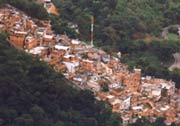
|
| A
typical "farvella" in the outskirts of Rio
|
| The
beach, a ritual and a way of life for the Cariocas,
is Rio's common denominator. Copacabana is probably
the world's most famous beach, and runs for 4.5km in front
of one of the most densely populated residential areas
on the planet. (It is also the place where you are most
likely to be robbed in Brazil.) From the scalloped beach
you can see the granite slabs that surround the entrance
to the bay. Ipanema is Rio's richest and most chic beach.
Other beaches within and near the city include Pepino,
Praia Barra da Tijuca, Flamengo and Aproador. |
|

Sunset
at
Copacabana Beach
|
| Pão de Açúcar
(Sugar Loaf) is God's gift to the picture-postcard industry.
Two cable cars climb 1300m above Rio and the Baía de Guanabara
and, from the top, Rio looks the most beautiful city in
the world. The 120 sq km Parque Nacional de Tijuca, 15
minutes from the concrete jungle of Copacobana, is all
that's left of the tropical jungle that once surrounded
Rio. The forest is an exuberant green, with beautiful
trees and waterfalls. Rio's famous glitzy Carnaval is
a fantastic spectacle, but there are more authentic celebrations
held elsewhere in Brazil. In many ways, Carnaval can be
the worst time to be in Rio. Everyone gets a bit unglued
at this time of year: taxi fares quadruple, accommodation
triples and masses of visitors descend on the city to
get drunk, get high and exchange exotic diseases. |
A
paradies for divers; Porto De Galighnas
|
|
| |
De Facto do Brazil:
Brazil
is the world's fifth largest country, after Russia,
Canada, China, and the USA. It borders to every country
in SouthAmerica except Chile and Ecuador. Its 8.5 milliom
sq km cover almost half the continent. Its population
is around 155 million, making sixth most populous country
in the world.
Source: Lonely Planet, South America
rimu
|
|
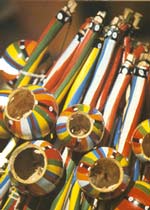
|
|
Colonial
Portugiesian
Style
|
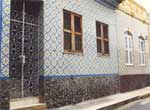
São
Louis, Bahia 1998
|

Saõ
Lous, Pernambuco, 1998
|

Recife with 'Copacabana do Recife' in the Background |
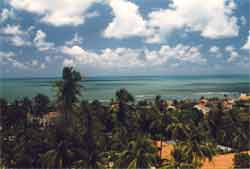
Recife,
Pernambuco, 1998
|
| Olinda
Brazil's former capital, Olinda is one of the best
preserved colonial cities in Brazil. With an enviable
elevated location overlooking Recife and the Atlantic,
the historical district is concentrated on its winding
upper streets. However, this is no still life. Olinda
is very much a living city, with a cultural scene which
is also alive and kicking, and its beautiful enclave of
preserved colonial buildings is populated by artists,
students and bohemians. Churches, museums, art galleries
and convents vie with outdoor restaurants and craft markets,
attracting locals and tourists alike. Carnaval in Olinda
is a mega affair, the historic setting and party-animal
residents providing an intimacy and sense of security
that other Carnavals lack. |
| Salvador
da Bahia or just Bahia is Brazil's most Africanised
state. Its capital, Salvador da Bahia (often abbreviated
to Bahia or Salvador), is a fascinating city loaded with
historic buildings. If beaches are what you want, the
only difficulty is making a choice. Founded in 1549, Salvador
was Brazil's most important city for 300 years, and the
Portuguese Empire's second city, after Lisbon. As the
centre of the sugar trade, it was famous for gold-filled
churches and beautiful mansions, and for its many wild
festivals and general sensuality and decadence. Carnival
in Salvador is justly famous and attracts hordes of tourists.
Other highlights include 34 colonial churches; the Museu
Afro-Brasileira, which is dedicated to Black culture;
and the Elevador Lacerda, an Art Deco structure with clanking
electric elevators which truck up and down a set of 85m
cement shafts in less than 15 seconds and carry over 50,000
passengers daily between the port and the hilly historic
section of the city. |
 |

Salvador

Bahia
do Brazil, 1998
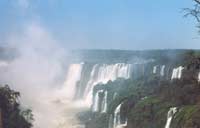
Foz De Iguacu
| Iguaçu Falls
The Rio Iguaçu arises in the coastal mountains of Paraná
and Santa Catarina, the Serra do Mar, and snakes west
for 600km before it widens majestically and sweeps around
a magnificent jungle stage, plunging and crashing in tiered
falls at the border with Argentina and Paraguay. The 275
falls are over 3km wide and 80m high. The best time of
year to see them is from August to November, when there
is least risk of flood waters hindering the approach to
the catwalks. |
|
The Pantanal The
Amazon may have all the fame and glory, but the Pantanal
is a far better place to see wildlife. This vast area
of wetlands, about half the size of France, lies in
the far west of Brazil and extends into the border regions
of Bolivia and Paraguay. Birds are the most frequently
seen wildlife, but the Pantanal is also a sanctuary
for giant river otters, anacondas, iguanas, jaguars,
cougars, crocodiles, deer and anteaters. The area has
few people and no towns, and access is via the Transpantaneira
road which ends at the one-hotel hamlet of Porto Jofre.
Boat tours are available from the port city of Rio Paraguai
on the Bolivian border, but be cautious as the town
has a reputation for gun-running, drug traffic and poaching.
|
|
Culture
Brazilian culture has been shaped not only by the Portuguese,
who gave the country its religion and language, but
also by the country's native Indians, the considerable
African population, and other settlers from Europe,
the Middle East and Asia. Brazilian music has always
been characterised by great diversity and, shaped by
musical influences from three continents, it is still
developing new and original forms. The samba, which
reached the height of popularity during the 1930s, is
a mixture of Spanish bolero with the cadences and rhythms
of African music. Its most famous exponent was probably
Carmen Miranda, known for her fiery temperament and
fruity headdresses. The more subdued bossa nova, popular
in the 1950s and characterised by performers such as
João Gilberto and songs such as 'The Girl from Ipanema',
was influenced by North American jazz.
The Brazilian Indians
never developed a centralised civilisation like the
Inca or Maya, and left very little evidence for archaeologists
to study: some pottery, shell mounds and skeletons.
The Indian population was quite diverse and there were
an estimated two to five million living in the territory
that is now Brazil when the Portuguese first arrived.
Today there are fewer than 200,000, most of them in
the hidden jungles of the Brazilian interior.
Vice President Itamar
Franco became president in December 1992 on Collor's
resignation, and in November 1994, Fernando Cardoso
was elected president. Cardoso has reduced the inflation
rate significantly since taking office, but this has
been offset by the loss of two million jobs between
1989-96, and ongoing problems with agrarian reform -
now being treated as a national security issue. According
to a 1996 United Nations report Brazil has the world's
most unequal distribution of wealth.
|
|
|